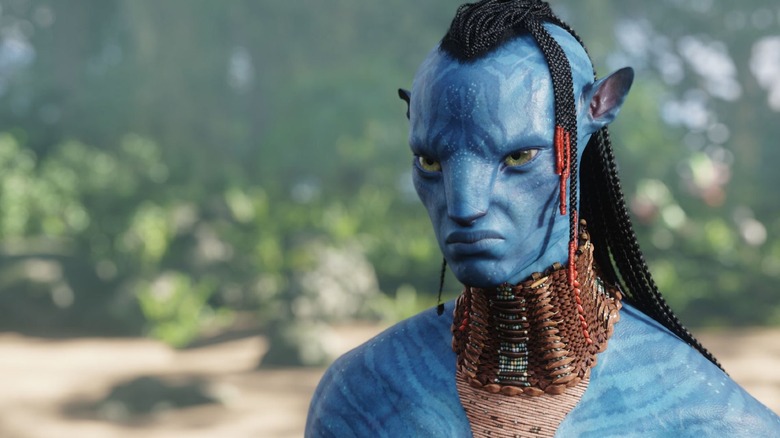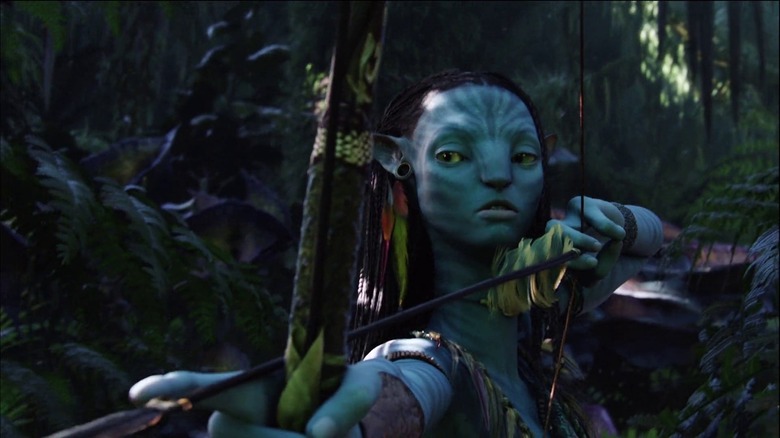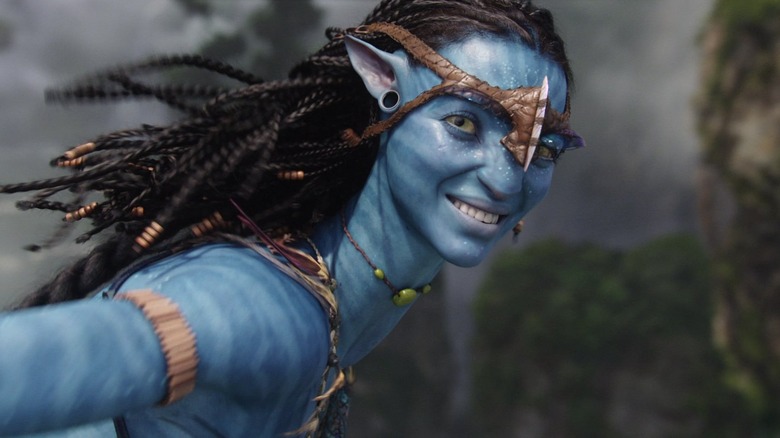Avatar's Mocap Tech Caused Some (Literal) Headaches For The Cast
For whatever complaints some might level at James Cameron's "Avatar" for being forgettable, it certainly influenced movie special effects to a degree that audiences have seen in every CGI-based blockbuster film made since. Facial motion capture, as it was pioneered in "Avatar," would make films like "Dawn of the Planet of the Apes," "Avengers: Infinity War," "Read Player One," and even the widely-seen smash hit "Valerian and the City of a Thousand Planets" possible. While facial motion capture certainly predates "Avatar," it had never been done with that particular level of detail before.
The technique used to capture such expressiveness on Na'vi faces involved outfitting actors with enormous helmets outfitted with outcroppings, wires, and cameras. Their faces would be dotted with computer-readable reference points — the more reference points, the more detailed the computer rendering — and miniature cameras would be angled to capture their expressions. With a surfeit of visual information and motion points, a textured CGI face could be modeled after their every eye twitch and mouth movement, making a false face look like a real one. Say what you will about the characters or the script of "Avatar," the special effects used to realize Na'vi is as dazzling as everyone says it was. In 2022, the effects still hold up.
Those helmets, though, might made some actors shudder to recall them. In a 2010 interview with FilmFestival.com, Cameron and star Zoe Saldaña recalled working with the helmets and what a literal headache they were.
Authenticity through technology
Cameron explained in the interview why such a complex rig was required, understanding that the infinite nuances of the human face would not be captured any other way. Subtle eye movements, he felt, were key.
"It's the eyes, and it was also the entire face. We have almost as many muscles in just our face as we have in the entire rest of our body. So the systems previously that we used were good at capturing body performance, we basically did the same thing. But we completely changed the way the face was captured. The way Zoe's mind reacts with her facial muscles is going to be very different than the way Sam's does and the other actors do. So it wasn't just a question of the perfect CG model for these characters.
Meanwhile, Saldaña felt that such attention to detail was a wonderful way of unlocking the spirituality of the characters; The Na'vi are connected to their planet — in some cases quite literally (they have psychic tendrils that lace into living creatures). The tech, she feels, was secondary to the trust created between actors and a director who were free to be themselves.
"Everything comes into consideration, from their physical anatomy to the slightest detail, obviously with Jim guiding us. But then there's the spiritual side of the characters. The Na'vi don't have a word for 'lie.' They don't live a lie; they don't know what a lie is. Everything they do is so genuine and pure, even from the way they turn to address each other, has a trust in it. We would always talk about that.
But that trust was achieved through throbbing temples. Early renditions of the facial rigs, it turns out, didn't fit quite well.
The helmets
Cameron claims that "Avatar" was the first film to employ the types of facial recording helmets that they did. As "Avatar" took so long to film, the techniques use for said helmets advanced quite a bit. Both Cameron and Saldaña talked openly about how badly they fit and how painful they were to use. "If I'm not mistaken, the first [version of the helmet] was very painful." Saldaña readily agreed. Luckily, a little bit of reshaping from a famous creature-making studio set things right. Said Saldaña:
"Standing, it was okay. But the moment you incorporated physicality ... There were like bottles of Advil for Sam and I on the set. Next we went to Stan Winston's company. They made a model of our entire head. Within two weeks, we all had our own helmets. We had our own head-rig that was molded to our head, and it was nice and cushiony! Sam drilled holes in his so he could breathe."
Thanks to no longer having to worry about balancing a painful head rig, Saldaña could now focus on the parts of playing her character, Neytiri, that involved more elaborate physicality. She learned how to shoot arrows and ride horses, all essentially in mime. Without a splitting headache, Saldaña could also remember her Na'vi vocabulary (as Na'vi was a conlang all its own).
"By the end of the shoot, it was easier for me to shoot an arrow using three fingers and my hand facing on the inside of my body, and ride a horse using no saddle and not holding the horse at all, than to speak English in a Na-vi accent. That was the biggest challenge. It was Na'vi."
"Avatar: The Way of Water," the long-in-production sequel to "Avatar" is coming to theaters this December.


